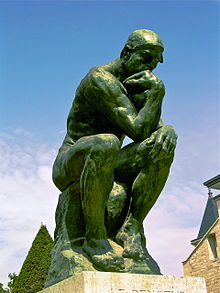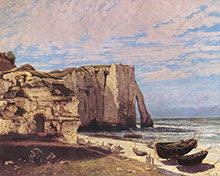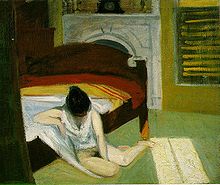Realism was an artistic movement that began in France in the 1850s, after the 1848 Revolution. Realists rejected Romanticism, which had dominated French literature and art since the late 18th century. Realism revolted against the exotic subject matter and exaggerated emotionalism and drama of the Romantic movement. Instead it sought to portray real and typical contemporary people and situations with truth and accuracy, and not avoiding unpleasant or sordid aspects of life. Realist works depicted people of all classes in situations that arise in ordinary life, and often reflected the changes wrought by the Industrial and Commercial Revolutions. The popularity of such ‘realistic’ works grew with the introduction of photography — a new visual source that created a desire for people to produce representations which look “objectively real.”
The Realist movement began in the mid-19th century as a reaction to Romanticism and History painting. In favor of depictions of ‘real’ life, the Realist painters used common laborers, and ordinary people in ordinary surroundings engaged in real activities as subjects for their works.
American Realism was an early 20th-century idea in art, music and literature. American realist painters were interested in creating new and more urbane works that reflected city life and a population that was more urban than rural in America as it entered the new century.
Most Famous Realist Artists:
 Auguste Rodin (1840-1917) was a French realist sculptor. Although Rodin is generally considered the progenitor of modern sculpture, he did not set out to rebel against the past. He was schooled traditionally, took a craftsman-like approach to his work, and desired academic recognition, although he was never accepted into Paris’s foremost school of art. Rodin possessed a unique ability to model a complex, turbulent, deeply pocketed surface in clay. Many of his most notable sculptures were roundly criticized during his lifetime. They clashed with the predominant figure sculpture tradition, in which works were decorative, formulaic, or highly thematic. From the unexpected realism of his first major figure – inspired by his 1875 trip to Italy – to the unconventional memorials whose commissions he later sought, Rodin’s reputation grew, such that he became the preeminent French sculptor of his time. By 1900, he was a world-renowned artist, and remains one of the few sculptors widely known outside the visual arts community. Rodin’s most famous work is “The Thinker” (1879-1889).
Auguste Rodin (1840-1917) was a French realist sculptor. Although Rodin is generally considered the progenitor of modern sculpture, he did not set out to rebel against the past. He was schooled traditionally, took a craftsman-like approach to his work, and desired academic recognition, although he was never accepted into Paris’s foremost school of art. Rodin possessed a unique ability to model a complex, turbulent, deeply pocketed surface in clay. Many of his most notable sculptures were roundly criticized during his lifetime. They clashed with the predominant figure sculpture tradition, in which works were decorative, formulaic, or highly thematic. From the unexpected realism of his first major figure – inspired by his 1875 trip to Italy – to the unconventional memorials whose commissions he later sought, Rodin’s reputation grew, such that he became the preeminent French sculptor of his time. By 1900, he was a world-renowned artist, and remains one of the few sculptors widely known outside the visual arts community. Rodin’s most famous work is “The Thinker” (1879-1889).
 Jean-François Millet (1814–1875) was a French painter and one of the founders of the Barbizon school in rural France. Millet is noted for his scenes of peasant farmers; he can be categorized as part of the movements of Realism and Naturalism. While Millet was walking the fields around Barbizon, one theme returned to his pencil and brush for seven years—gleaning—the centuries-old right of poor women and children to remove the bits of grain left in the fields following the harvest. He found the theme an eternal one, linked to stories from the Old Testament. In 1857, he completed one of his most well known paintings, The Gleaners, and submitted the painting to the Salon to an unenthusiastic, even hostile, public.
Jean-François Millet (1814–1875) was a French painter and one of the founders of the Barbizon school in rural France. Millet is noted for his scenes of peasant farmers; he can be categorized as part of the movements of Realism and Naturalism. While Millet was walking the fields around Barbizon, one theme returned to his pencil and brush for seven years—gleaning—the centuries-old right of poor women and children to remove the bits of grain left in the fields following the harvest. He found the theme an eternal one, linked to stories from the Old Testament. In 1857, he completed one of his most well known paintings, The Gleaners, and submitted the painting to the Salon to an unenthusiastic, even hostile, public.

Gustave Courbet was a French painter who led the Realist movement in 19th-century French painting. The Realist movement bridged the Romantic movement (characterized by the paintings of Théodore Géricault and Eugène Delacroix) with the Barbizon School and the Impressionists. Courbet painted figurative compositions, landscapes, seascapes, and still-lifes. He courted controversy by addressing social issues in his work, and by painting subjects that were considered vulgar, such as the rural bourgeoisie, peasants, and working conditions of the poor. His work belonged neither to the predominant Romantic nor Neoclassical schools. Courbet believed that the only possible source for living art is the artist’s own experience.

– Edward Hopper
Edward Hopper (1882–1967) was a prominent American realist painter and printmaker. Hopper is the most modern of the American realists, and the most contemporary. While most popularly known for his oil paintings, he was equally proficient as a watercolorist and printmaker in etching. In both his urban and rural scenes, his spare and finely calculated renderings reflected his personal vision of modern American life.

